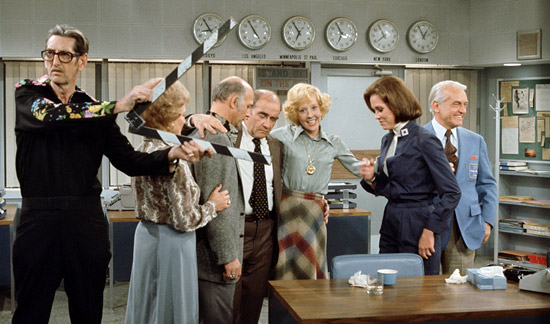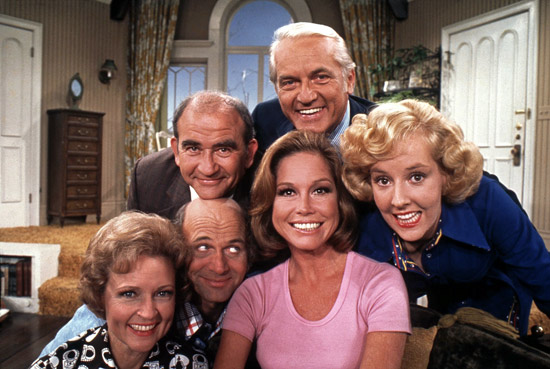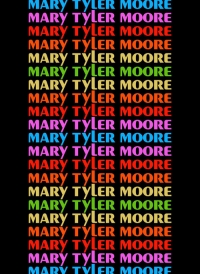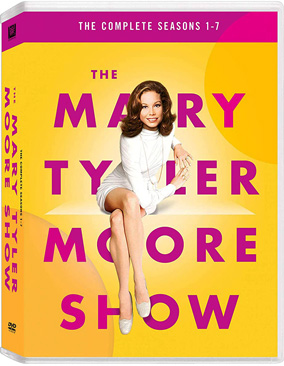
Coate: Which character is your favorite?
Pilato: Beyond the wonderful leading character of Mary Richards, portrayed so perfectly by Mary Tyler Moore, my favorite characters are Lou Grant and Rhoda Morgenstern. Ed Asner and Valerie Harper did such remarkable jobs in those roles. Both were such strong characters, and much tougher on the outside then they were on the inside. They just utilized their tough exteriors as a buffer for survival. They gave male and female viewers someone to bond with and admire, without being perfect. Instead, the audience connected with them, as I did, on a human level. And that’s how it was with each of the characters on the show. Everyone who watched the show had their pick of personal favorite characters to identify with, because there was such a vast number of choices available, each so different, but all so likable in so many ways…even when they said or did things that were unlikable. For example, Ted Knight as Ted Baxter, Betty White as Sue Ann Nivens, and Cloris Leachman as Phyllis Lindstrom each acted at times in unlikable ways. But it was the actors’ performances as their given characters that were likable. It’s an age-old pattern or strategy of likability that was also utilized by Larry Hagman as J.R. Ewing on Dallas, TV’s legendary prime-time soap, or W.C. Fields in the early cinema. Like Ted, Sue Ann, and Phyllis on The Mary Tyler Moore Show, Hagman and Field’s likable performances outweighed the un-likability of the characters they portrayed.
Waldron: All the show’s characters were so well-drawn, it’s hard to choose one over another. But just for fun, I’d have to pick Bess Lindstrom, Phyllis’ wise-beyond-her-years daughter, who also happened to be the only character on the show who was about my age when I first watched it.
Coate: Which are the series’ standout episodes?
Pilato: There are so, so many. But a few come to mind immediately: Chuckles Bites the Dust, in which Chuckle’s the Clown, the local WJM-TV character, dies from injuries he received by being dressed as a peanut in a parade, when he was subsequently stomped by an elephant. The Seminar, in which Mary travels to Washington with Lou, who attempts to impress her with all of his former contacts who simply no longer exist…except for one…Betty Ford, who makes a cameo appearance. But Mary doesn’t believe Lou knows anyone important, especially Betty Ford. In the course of the episode, we see an interesting dynamic develop between Mary and Lou that we had not really seen before. Mary doesn’t seem as gullible anymore as she once was with Lou, as she mixes in a little sarcasm with her disbelief of Lou’s alleged upper-crest friends. And then there’s the episode, Lou Dates Mary, in which Mary and Lou decide to take their relationship beyond the friendship zone. When they return to Mary’s apartment after their first “date,” they attempt to kiss, then almost immediately realize that any potential romance between them is simply not in the cards. There are countless other wonderful episodes that are terrific, too…as when Mary throws any one of her not-so-successful parties…or when in Put On A Happy Face, nothing goes right for her when she is to receive an award. She ends up at the podium with stained dress, a sprained foot, a terrible cold, and really bad hair. But each of the show’s characters get their own moment to shine in the spotlight like that, so to speak.
Waldron: The pilot and closing episodes were both textbook examples of how to launch — and end — a TV series. In between those two, a short, and by no means complete, list of highlight shows would include Bob and Rhoda and Teddy and Mary, which introduced the much sought after but ever-elusive Teddy Award; The Boss Isn’t Coming to Dinner, a first season show that deepened Mary and Lou’s relationship in ways that would pay dividends later in the series; Rhoda the Beautiful, another great Rhoda show written by Treva Silverman, who I always thought of as the voice of that character; The Lars Affair, which introduced Betty White’s Sue Ann Nivens, and also earned Cloris Leachman a well-deserved Emmy; Mary Moves Out, a bittersweet show that marked Mary’s transition from the insecure single gal of the earliest episodes to the more mature and independent Mary Richards we’d come to know in the show’s two final seasons.

Coate: Which episode is your favorite (if you could name only one)?
Pilato: It’s gotta’ be Chuckles Bites the Dust, which was Mary’s favorite episode. She is brilliant throughout the entire situation, displaying her multi-talents as an actress and as a comedian, presenting the gamut of emotions, all in thirty minutes, from disgust to laughter to ultimately tears. Meanwhile, too, she brings the audience to tears throughout…in a good way. She has us laughing so hard, we’re crying.
Waldron: I always laugh hardest at shows that focus on Ted Baxter, so I’ll choose Two Wrongs Don’t Make a Writer, written by David Lloyd. That’s the one where Ted horns in on a creative writing course that Mary’s taking, and ends up claiming her assignment as his own, leaving her to make up a brand new composition on the spot when it’s her turn to present her work to the class. It was a very funny show, and a textbook example of Mary Tyler Moore and Ted Knight at the peak of their form.
Coate: If you were to introduce the show to someone, which would be the best gateway episode (if not the pilot)?
Pilato: Tough call. But I’d say, Put On A Happy Face, which showcases both the vulnerability and courage of Mary Richards as a character and Mary Tyler Moore, again, and as an actress and performer.
Waldron: Another hard one to narrow down, but I think I’ll pick Support Your Local Mother, the episode that introduced Rhoda’s mother with an outrageous, if completely relatable, premise that Rhoda is a grown woman who simply can’t stand to be in the same room with her overbearing mother. CBS hated the script, which they thought was an abomination that skewered mom, America and apple pie. The network actually threatened not to air the episode until Grant Tinker stepped in to back his writers, and CBS relented. The show went on earn an Emmy for writers Allan Burns and Jim Brooks.
Coate: Where do you think The Mary Tyler Moore Show ranks among 1970s era sitcoms?
Pilato: Number 1. First of all, it debuted in 1970, and kicked off the decade. Secondly, it featured an established, beloved star, aka “America’s Sweetheart.” Thirdly, the acting, writing and directing was superior, and they have the Emmys to prove it.
Waldron: When I conducted a national poll of TV critics in the mid-80s to choose the shows for my first book, Classic Sitcoms, The Mary Tyler Moore Show landed in the top spot, and found it hard to argue with the critical consensus then. If I conducted that poll today, I don’t expect Mary Tyler Moore would rank first, but I have no doubt it would still poll within the top ten.
Coate: Do you believe The Mary Tyler Moore Show has been adequately represented on home video?
Pilato: The show received a very nice DVD set. But the time has arrived for it come on Blu-ray.
Waldron: Sadly, no. The show’s roll-out on home video was so beset by delays and marketing missteps that a business school professor could probably use the show as an object lesson in how not to exploit a beloved TV property.

Coate: What is the legacy of The Mary Tyler Moore Show?
Pilato: The legacy of The Mary Tyler Moore Show is so many things wrapped-up in seven years of a series that starred one of the most charming, likable, adorable, talented and intelligent actresses in the history of entertainment. Mary Tyler Moore was a diverse performer, complex human being, animal advocate, and savvy business woman who left us all too soon. But the immortal work she left behind is so perfectly represented by The Mary Tyler Moore Show — a groundbreaking, influential television series that spoke to heart of humanity…our country…our world…female empowerment, and so much more…and did it all with a smile….“with her smile.”
Waldron: It opened the floodgates for the kind of grown-up TV comedies that would thrive in the 1970s, and beyond. Although Mary’s show had little in common with M*A*S*H, All in the Family, or Barney Miller, it’s hard to imagine any of those breakthrough sitcoms getting a green light had The Mary Tyler Moore not proven to the TV networks that it was possible to attract a sizable audience to intelligent, risk-taking television shows — that good TV was, in fact, a viable business model.
Coate: Thank you, Herbie and Vince, for sharing your thoughts about The Mary Tyler Moore Show on the occasion of its 50th anniversary.
IMAGES
Selected images copyright/courtesy CBS, MTM Enterprises, 20th Century Fox Home Entertainment.
- Michael Coate
Michael Coate can be reached via e-mail through this link. (You can also follow Michael on social media at these links: Twitter and Facebook)





